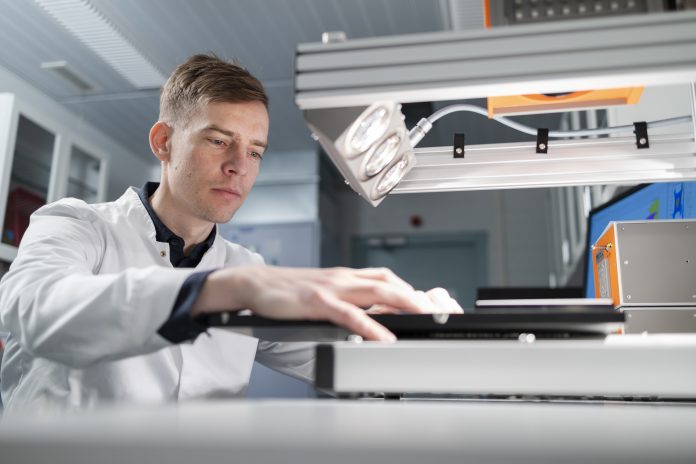Mikko Mäkelä, Research Professor at VTT, discusses the possibilities of a hyperspectral camera – a device that can see things which the human eye cannot
“The human eye sees colours and is able to tell apples from pears based on their colour and shape. A hyperspectral camera, on the other hand, shows what condition the fruit is in and when it will go bad”, explains Research Professor Mikko Mäkelä.
In the 90s, a NASA scientist by the name of John Bolton moved to Finland together with his wife. He had an idea to create a hyperspectral camera that could be used to survey the condition of forests. The VTT team in Oulu jumped at the opportunity to get on board:
“Before the aeroplane project, I had to develop a simple and compact spectrometer structure that could be attached to a fibre optic cable. This structure in fact enabled the development of a new kind of simple imaging spectrometer, which was then patented in the early 90s.
“It was very jolly to see how the very first prototypes for the imaging spectrometer worked as they should. We saw that there was a demand for this technology, so a spin-off company, Specim, was set up in 1995 to work on commercialising it.
Specim is now racing ahead at a dizzying pace, and its imaging spectrometers are well known throughout the world,” recounts long-time researcher Mauri Aikio, who has been working with hyperspectral imaging for more than 30 years.
A hyperspectral camera can measure several hundred different wavelengths
This technology is certainly not threatened by obsolescence – quite to the contrary, enthusiastic researchers such as Mäkelä still use it in their research, and it continues to be harnessed in world-changing endeavours.
Mäkelä goes on to explain what makes hyperspectral camera imaging so special. Let’s compare it, for example, to the everyday digital camera that is familiar to us all. A digital camera measures the intensity of light using three wavelengths of visible light: red, green and blue.
The human eye itself is able to distinguish these colours. A hyperspectral camera, on the other hand, measures as many as several hundred different wavelengths from both the visible spectrum and beyond. The images produced contain information on things such as the object’s chemical properties.
The result is therefore a kind of machine vision – a device that can see things which the human eye cannot.
Reaching beneath the surface
Researcher Heikki Saari has also been working at VTT since the beginning of the hyperspectral imaging journey, and his varied work has included the development of a device for diagnosing skin cancer.
“Hyperspectral imaging was getting attention already in the 90s as part of efforts to measure the ozone layer. Our technology has also been launched into space aboard a number of different satellites – including projects carried out with NASA.
“I have also invented a hyperspectral camera imaging method, using a unique MEMS technology that enables the cheap manufacture of small-scale hyperspectral cameras that in the future could be integrated into phones. Our job is to get this technology integrated into mobile phones. After that, the different applications for it will emerge as people creatively make use of it,” Saari explains.
Hyperspectral imaging is used in many different ways – and there are no doubt more applications still to be discovered. Cameras are installed, for example, on satellites and then sent into space to analyse the atmosphere, or they are attached to drones for surveying the condition of forests.
In the coming years, they will also be used to separate different textile materials from waste flows. Hyperspectral cameras are also part of an ambitious project in Mumbai, India, to clear out plastic waste from one of the world’s most polluted rivers. In this project, the cameras help to identify plastic floating on the surface.
Hyperspectral imaging and the age of digitalisation
Ultimately, hyperspectral imaging is something that fits perfectly with the essence of digitalisation. The measurements are extremely fast compared to the alternative of laborious and expensive laboratory work. There basically isn’t any sample preparation required, yet we can still get a huge amount of data quickly and easily.
“I used to do experiments in the laboratory for three weeks and then spend a day or two afterwards chewing over the data. Now it has flipped around the other way – I spend a day imaging and then a month crunching the code.”
“I haven’t yet come up with any other method which can gather so much data in such a short time. Within the research itself, the images and the physics involved combining with chemistry and applied mathematics. Through machine learning, chemistry is transformed into visual and quantitative data”, says Mäkelä.
And how does the future look to Mäkelä? Part of his work currently involves textiles, and he hopes that in the future hyperspectral imaging could be used to digitalise the manufacture of new and more uniform materials for different applications. New possibilities are constantly emerging, however, so time will tell where the technology ultimately brings the biggest change.
Read more about the possibilities of imaging technologies at www.vttresearch.com
Please note: This is a commercial profile
© 2019. This work is licensed under CC-BY-NC-ND.











